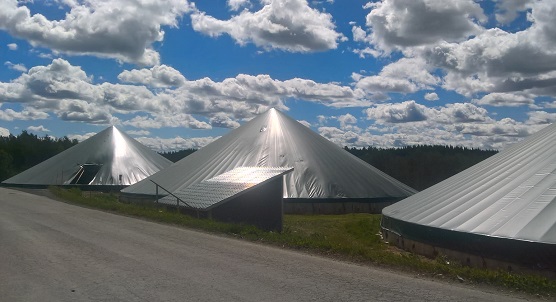
Storing recycled fertilizers in Biokymppi's property in Kitee.
The biogas plant digestate is mostly suitable to be used as fertilizers and dressing. The biogas is produced in a closed process, which means that the nutrients contained in the raw materials remain in the process. Due to the high nutrient content, biogas end-products are typically more suitable for fertilizer use than unprocessed raw materials. By using the digestate as a fertilizer, mineral fertilizer use can be decreased and a nearly closed nutrient recycling can be achieved.
The biogas process generates solids similar to humus, water and carbon dioxide as well as methane, which can be used as energy. Depending on the decomposability of raw materials, 40-70 % of the organic matter is decomposed during biogas production. The portion of decomposing raw material depends on decomposition rates of carbon hydrates, proteins and fat. These can be determined, but in practice there is some variation involved. Manure is a suitable main raw material for biogas production since it is constantly available, it includes nutrients for microbes and the alkalinity value is high. As for feed material in farms, plants harvested green have the best methane production potential. Phosphorous, potassium and micronutrients do not change significantly during the process.
A portion of organic nitrogen in manure transforms into ammoniacal nitrogen, which is suitable for plants. Depending on the type of manure and processing conditions, 20-30 % of the total nitrogen transforms into ammonium (in plant biomass as feed, 50-85 % is transformed). In general, 40-60 % of nitrogen in digestate is ammoniacal nitrogen. This means, that biogas processing substantially decreases greenhouse gas emissions of manure and other organic raw materials, but transforming nitrogen into ammoniacal nitrogen can generate ammonia emissions. Most of the greenhouse gases are generated in the storage phase, but these emissions are smaller than emissions of unprocessed manure. Emissions of digestate are mainly generated during spreading (96 % in surface spreading). Therefore, injection spreading should be used to avoid evaporation of nitrogen and leaching. Fertilization effect of solid nitrogen is also maximized. Ammonia emissions of digestate can be decreased by covering storages.
Digestate prodcution decreases the amount of phytotoxins and increases homogenous quality and runniness of manure, making it more suitable for spreading. Odor is decreased up to 80%. At the same time, pathogens and weed seeds are eliminated as well as organic hazardous substances such as phthalate used as plastic processing and polycyclic aromatic hydrocarbon (PAH), making digestate safer to use.